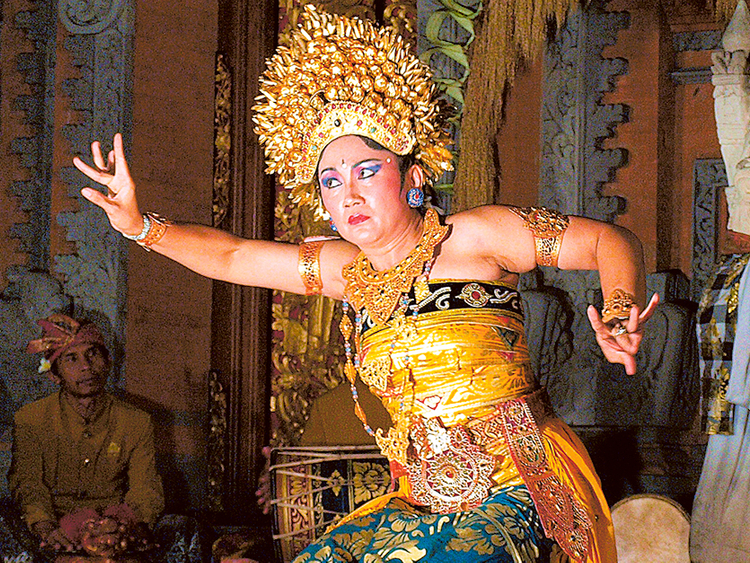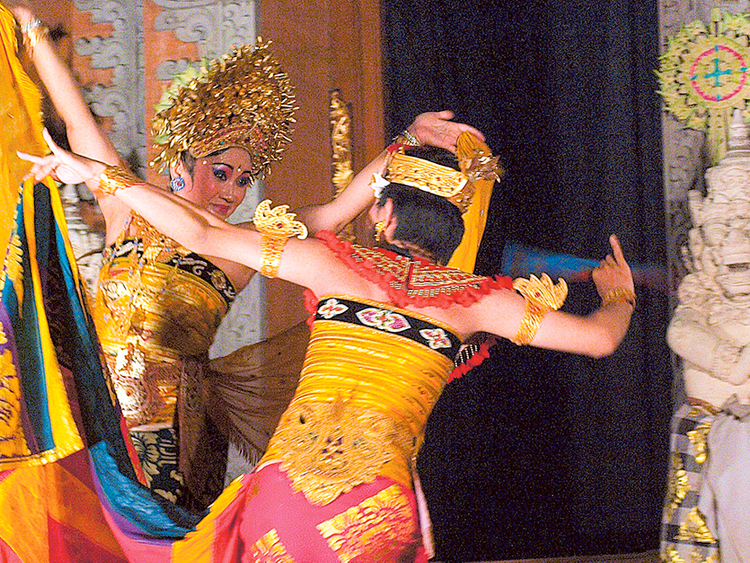
Legong is a “balih-balihan”, or secular, Balinese dance form meant “purely for entertainment” and has “no propaganda”. Though it is performed at temple ceremonies, the performance takes place outside the temple, in a separate courtyard. The concept of Balinese classical dance is quite different from Western traditions. In the West, the dancer has to express his or her inner self and personality whereas Balinese dancers drift far away from their personal self, “the ego” as they understand it, letting “the spirit” (“taksu”) they are playing talk and dance on their behalf. It is an act of submission to a higher form of guidance — an act of self-offering, of a moment of being one with the “things we cannot see” (“niskala”).
The controversial three-part classification of dance forms adopted in 1971 was motivated by a desire to prevent commercialisation of ritual dances as tourist fare. Broad distinctions were drawn between “wali” (sacred), “bebali” (ceremonial) and “balih-balihan” dances. From the root word or base “balih” (that which is watched), “balih-balihan” can be rendered as “spectacle” or “performance”.
Since the 1920s, 90-minute abridged versions of legong have featured in concerts organised for guests (tourists) and this version has travelled overseas with Balinese orchestra troupes performing internationally. The dance has become culturally emblematic of Bali to the world.
Traditionally, the dancers are three young girls; the servant (“condong”, typically seen only with Legong Lasem where the maid also returns at the end in the role of a raven), who dances a prelude, and two main performers. All wear elaborate gold-brocade costumes with ornate accessories and large frangipani-crowned headdresses.
Legong’s refined dance moves are characterised by intricate finger movements, complicated footwork and expressive gestures and facial expressions. This dance form can be seen all over Bali, but is most common in the area around Ubud, where it is regularly performed for travellers. The Ubud Palace’s legong performances are the most popular.
Origins
Legong probably originated in the 19th century for royal entertainment. The word legong has been interpreted differently and its origins are debated till date. What is certain is that legong developed during the feudal era. Legong is known as the dance of the virgins as it was traditionally performed by pre-pubescent girls in the palaces of feudal Bali.
The word legong is made up of two words — “lega” (happy) and “wong” (person), and put together, they can be understood as “a dance that makes one happy”. The word can also be divided as “oleg” (dance) and “gong” (gamelan, the traditional music that accompanies the dance).
Dance is a very deep-set aspect of life in Bali. Each village seems to have skilled dancers and gurus. If you strike a conversation with a local, they often name-drop their favourite local dance icons.
There is a theory that long ago, the original legong was performed by young boys in the courts. That time the dance was called nandir. There is a possibility that legong is much older than nandir.
The theory of the origins of legong derives from “Babad Dalem Sukawati”, which records the history of the kingdom of Sukawati and surrounding provinces. The King of Sukawati, I Dewa Agung Made Karna (1775-1825), meditated for 40 days and nights at the site of Pura (temple) Yogan Agung in Ketewel, adjacent to the village of Sukawati. In his dream (or trance), he saw two dancing celestial figures dressed in gold and wearing headdresses. Soon after, he had the temple built at the site and taught the court musicians and dancers what he had seen. The four dances in the repertoire are highly sacred and imbued with considerable spiritual power. They have a fixed choreography and are accompanied by a semar pegulingan orchestra. In them, the two dancers wear masks (“topeng”).
According to some versions, legong existed before the king had the dream. There is speculation that the dance came to Bali from eastern Java in the 14th century. In any case, the dance has a distinct Javanese style (a flange gripped in the dancer’s mouth gives away its place of influence). According to most accounts, prior to Karna’s dream, no one knew how the masks were to be used for the dance.
There are more than 15 stories in the legong repertoire. Jobog (monkey kings), Kuntul (pied stilts) and Lasem (a Majapahit king or ruler of Indonesian origin) are the most popular.
And of all the forms of legong, legong keraton is the most popular. Keraton is Javanese term for palace. It was named by the Sultanate of Keraton Surakarta when the music and dance composer and genius I Wayan Lotring from Kuta was invited to perform in the 1920s with his “pelegongan” (an old variety of the Balinese gamelan) group in the palace in Surakarta. The dance acquired this Javanese tag in the 1930s.
Each village in Bali has its own traditional legong performances. They narrate stories that are characteristic of a particular dance troupe or a folklore from a certain area. These stories are slice-of-life episodes. Tenun or weavers’ dance incorporates hand-weaving movements as dance steps. Similarly, in Belibis or dance of the wild geese, the dancers swing their legs in unison off the ground while keeping each leg straight and unbent.
Though categorised secular, the most popular and important legongs are those performed in praise of a deity or the divine spirit (such as Panyembrahma), and to welcome guests (or tourists nowadays). The dances have also been used as a means of teaching code of conduct. The right social etiquette that required people to lead a graceful and cultivated life are imparted through this medium — as portrayed in the warrior dance (Wiranata) and the seated dance (Kebyar Duduk).
Formerly, legong was patronised by local kings and performed at the residence of the royal family of the village. Young dancers were recruited based on their physical appearance. Today, the trained dancers are still very young. Girls as young as five aspire to be selected to represent the community as legong dancers. It is not unusual if a girl of 14 approaches retirement as a legong performer. But in some troupes you will find adult performers — marking a sign of change.
The Rangkesari story
Legong Keraton’s Lasem category enacts a drama of an abstract kind. The story is performed by three dancers — a female attendant of the court and two identically dressed legongs who adopt the roles of royal importance. The themed musical magnificence of the gamelan orchestra plays on the minds of the audience to conjure up imaginary changes of scene. The story dates back to history of East Java in the 12th century when its ruler finds Rangkesari, a maiden lost in the woods. He takes her home and locks her in a house of stone. Rangkesari’s brother, the Prince of Daha, learns of her captivity and threatens to attack the kingdom, unless she is set free. Rangkesari begs her captor to avoid war by giving her liberty, but the king prefers to fight. On his way to battle, he encounters a raven (a bird of ill omen) who predicts his death. As predicted, he is killed in the fight.
The dance dramatises various episodes — the farewell to the king as he departs for the battlefield and his ominous encounter with the bird are portrayed in all their vibrance by the little dancing actors. Decked from head to toe in shimmering gold brocade, it is a wonder the legong dancers can move with such grace and agility. The dancers flow from one character into the next without disrupting the flow of the story. They may enter as the double image of one character, their movements marked by tight synchronisation. Then they may split, each enacting a separate role, and come together again.
In a scene in which they rub noses one is reminded of a similar Emirati gesture of saying hello. When the king takes leave of Rangkesari, the drama is intense. The woman rejects his advances by hitting him with her fan, and he stomps out shuddering in anger.
The condong part of the performance was added by composer and musician A.A. Peririt from Sukawati around a decade ago. A complete legong keraton performance comprises more than 10 parts. However, these are customised and shortened for tourist performances. Today it is very rare to see a complete legong keraton performance, but the one at Ubud palace grounds is the most talked about.
It starts at 7.30pm every day at the Ancak Saji Ubud Palace Court Yard built in the 16th century. Few tips to enjoy the dance better — arrive a little early for front row seats, buy your tickets in advance and follow the story in the brochure. Professional cameras, tripods and flashes are not allowed at the venue without prior permission, although mobile watches (without flashes are permitted). One may not be able to go back with this memory in mobile cameras because the spectacle is performed in the light of giant oil lamps, which unfortunately does not record well in the dim light settings of most shutters.
The dances are performed exactly to the word as in the brochure. Legong Ramayana (wali category), which is a common item performed here, is based on the story of two brothers, monkey kings Subali and Sugriwa.
Subali (Balinese name for Vali or Bali from Ramayana) ruled the “vanara” (monkey) kingdom of Kishkindha. One day, a Mayavi (demon) challenges Subali to a fight or submit his kingdom. Subali accepts the challenge, but when he rallies forth, the demon flees in terror into the wild and into a cave. Subali enters the cave to fight the demon, instructing Sugriwa to wait outside. When Subali does not return, and upon hearing demonic screams from the cave, Sugriwa concludes that his brother is killed. With a heavy heart, he rolls a boulder to seal the cave’s opening to prevent the demon from returning to Kishkindha. Sugriwa then comes back and assumes kingship. Subali’s widow Tara now becomes the queen of Sugriwa.
Subali, however, had not died as presumed. It was the demon’s doing to cause a stir in Sugriwa’s heart. Subali fights the demon for ages in the cave, ultimately winning the combat. He returns home after removing the boulder. Seeing Sugriwa as king, he concludes that his brother had betrayed him. Though Sugriwa attempts to explain himself, Subali is deeply enraged. As a result, Sugriwa is ostracised from the kingdom. Subali also forcibly takes Sugriwa’s first wife Ruma as vengeance. The brothers became bitter enemies.
Classical dance forms of Bali
One of the most famous dances is the kecak that involves a chorus of seated men who vocalise the background score and sway their outstretched arms to accompany the drama. Kecak usually finishes with one of the most spellbinding sanghyang jaran dance, in which dancers go into a trance state and perform amazing feats such as walking on hot coals or stabbing themselves with daggers, emerging unhurt.
Another famous dance is the barong (a lion-like creature who is believed to protect the island as per Balinese mythology). He is the king of the spirits, and the dance involves a story of possession by demons, mythical creatures and the struggle between good and evil. Barong also make special appearances in legong performances.
The legong is the undoubtedly the queen of all Balinese dances, bringing to mind the grace of the island and its beautiful people.
Archana R.D. aka B’lu is an artist-journalist based in the UAE who writes on global art and culture.















